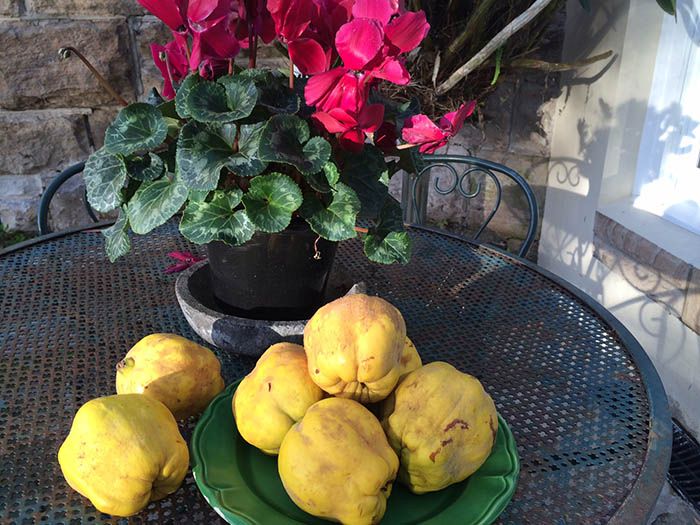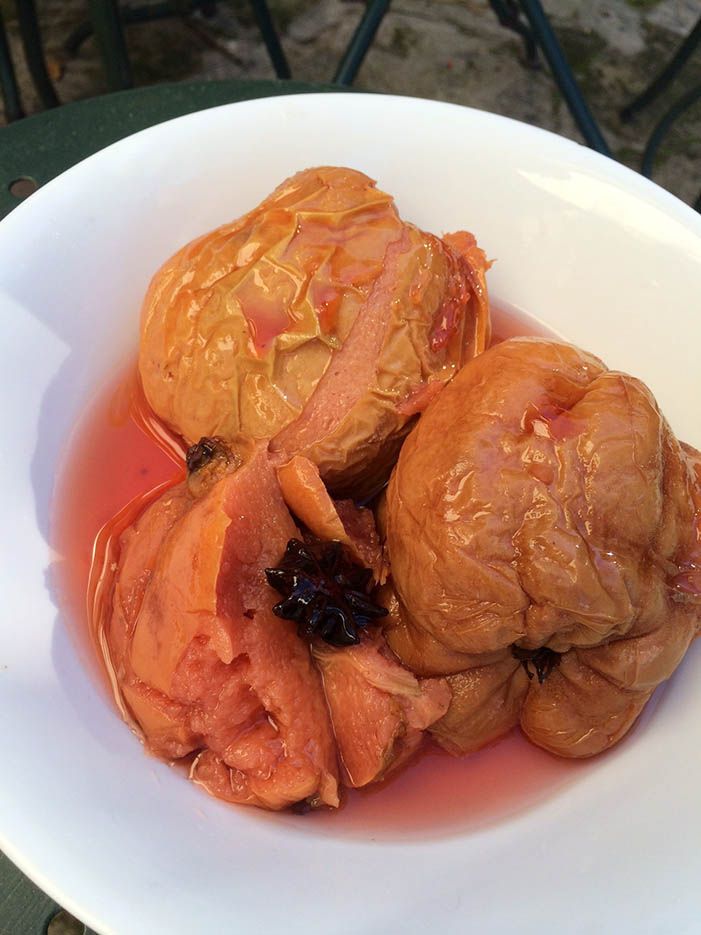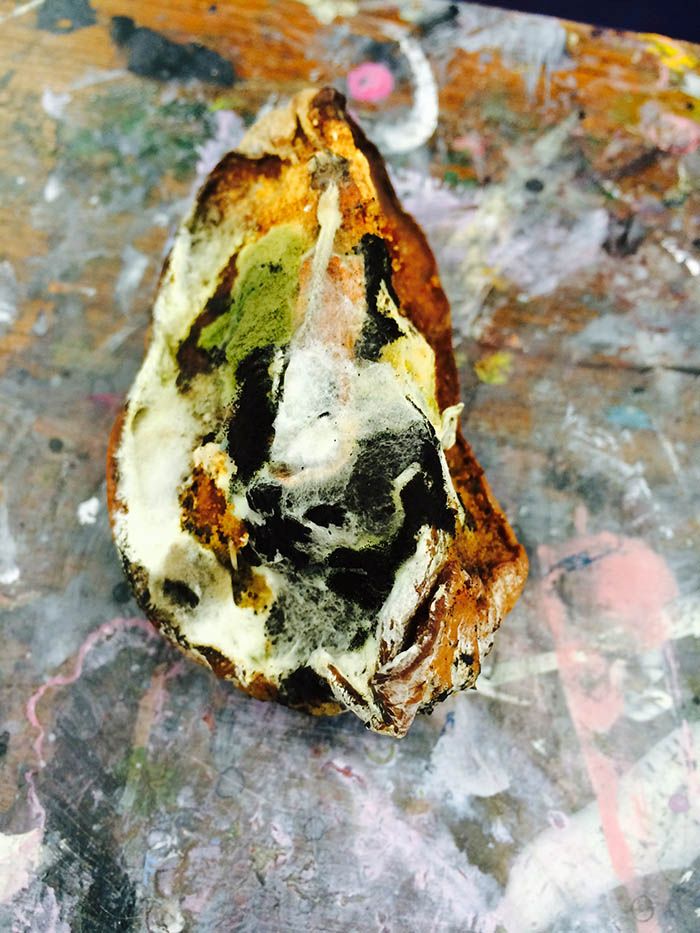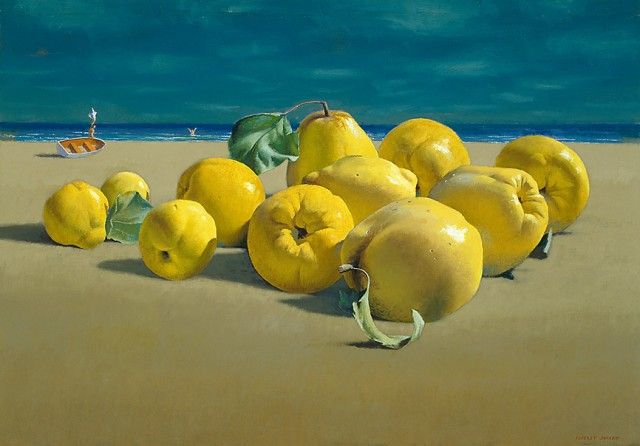Meditation on Quinces
It had a cloak of ash-coloured down hovering over its smooth golden body,
and when it lay naked in my hand,
with nothing more than its daffodil-coloured shift,
it made me think of her I cannot mention,
and I feared the ardour of my breath would shrivel it in my fingers.
Isn’t that Aphrodite’s apple?
– Shafer ben Utman al-Mushafi
Coming into the house, I can already smell the quinces.
Moments later, I’m standing by the sink, rubbing the fluff off them with a soft cloth, when my daughter asks,
“How do you tell when they’re ripe?”
I pick one up and hold it under her nose.
“Hmmm”, she exclaims.
She takes it from me and inhales its sweet scent again, this time more deeply, closing her eyes and pressing it against her upper lip and nostrils.
“So fragrant,” she exclaims, pausing for breath.
“And yet it’s as hard as concrete. When I press it, there is no give. Surely it’s not ripe?”
“Apples can be ripe, yet hard. ” I say. “Perhaps if it were green. But look, it’s the colour of sunshine.”
It’s the first time my daughter has shown much interest in quinces. Usually it’s my son who wanders into the kitchen looking for something to eat, sometimes offering a helping hand.
“I remember reading somewhere that children in Chile even eat it as a fruit,” I tell her. “They bash it against a wall until the flesh is bruised which apparently makes it more palatable, though I suspect they must be a different variety.”
These, I tell her, are Smyrna quinces.
“They have such an ancient history, originating in Turkey and Persia and have been cultivated by people for thousands of years. “
She’s losing interest now and rolls her eyes when I mention ancient history.
“Muuummm….,” she wails. But I persist.
“They’re more wrinkled and irregular in shape than some of the other varieties such as the pineapple quince, something I like about them.
“The pineapple quince is not as quince in flavour either and breaks up in long slow cooking.”
I’ve had a long love affair with quinces and each year look forward to their arrival at my local greengrocer. If you’ve never seen one, now is the time. It’s suprising how many people don’t know them, mistaking them for lemons or pears (their shape and colour are similar). At $4.99/kg they make sensible buying and once you start cooking with them, a whole new world will open up: jams, conserves, pastes, jellies, sauces, cakes, pies, sorbets, ice creams, soups, tagines and sambals. As they ripen from greenish yellow to deeper gold, the pectin levels drop, which means they are less suitable for jams and jellies, but still excellent for pot-roasting.
South Australian chef and food writer Maggie Beer has long been a fan of the quince. In her charming book, “Maggie’s Harvest” , she sings their praises and talks about planting her quince orchard, which numbers over 350 trees, at the Pheasant Farm in the Barossa Valley. “This wonderfully evocative fruit was my first link to the land in a sense,” she writes. “When we were looking for a place in the Barossa…we looked at many farmhouses and, even at the most derelict of places, where the gardens and orchards had been left unattended for years, there would be a surviving quince tree…the spring blossom makes a beautiful sight”.
Along with persimmons and pomegranates, they evoke for me the first mellow fruitfulness of autumn with its russet colours and cool days.
The ancient Greeks and Romans loved the quince and many believed it to be the `golden apple’ of classical legend. Jewish tradition believes the quince is the oldest of the fruits and that it grew in the Garden of Eden.
I grew up believing that Eve had been tempted by an apple in the garden, but some say it was a quince tree in which the snake dwelt.
Sadly today, the quince is a relatively neglected fruit.
I think the ancient Greeks and Romans knew better. They held the quince in high esteem, dedicating it to both Venus and Aphrodite as a symbol of happiness, love and fruitfulness. Eating one was a necessary preliminary before entering the marriage bed.
In the Old World, where it was eaten fresh, people could appreciate foods that were sour as well as sweet. Food writer Waverley Root suggests that slipped from favour when we became accustomed to sugar cane and adding sweetness.
Yet it is the combination of quinces with sugar and spice (and all things nice) that mesmerises me – how gradually, through long slow cooking, the flesh transforms from beige to pink and exudes its aromatic essence. Just magic.
The quinces can be cooked whole in a large pot on top of the stove, snuggled together tightly and covered with water, sugar and spices (cinnamon, star anise, cardamom) and left to simmer for 2 – 3 hours to soften and release their pink juices.
Once they are removed from the liquid, they can be left to cool a little and then cut them into quarters or eighths and serve drizzled with some of their juice and top with a good quality vanilla yoghurt or a little cream and vanilla ice cream.
The liquid is then reduced and the juice of a few lemons is added. It will turn ruby red and become a jelly when it is cold and you can spoon it onto your toast for breakfast or use it in marinades or to accompany roast pork.
Did you know that the Portuguese for quince is marmello and this is how the word marmalade came to the English and French languages?
When quinces are in season, my mother makes an upside down quince cake from The Cook’s Garden in which the quince slices are tossed in brown sugar, butter and cardamom seeds then placed at the bottom of a cake tin in a decorative patter and covered with a batter made with ground almonds, flour, eggs, butter, ground cardamom, baking powder and some of the quince syrup.
It needs about an hour in a moderate oven and when it is turned out, it’s not just its fragrance which will knock you out, it is also the beauty of the patterned crescent-shaped quince pieces luxuriating in a shimmering ruby jelly.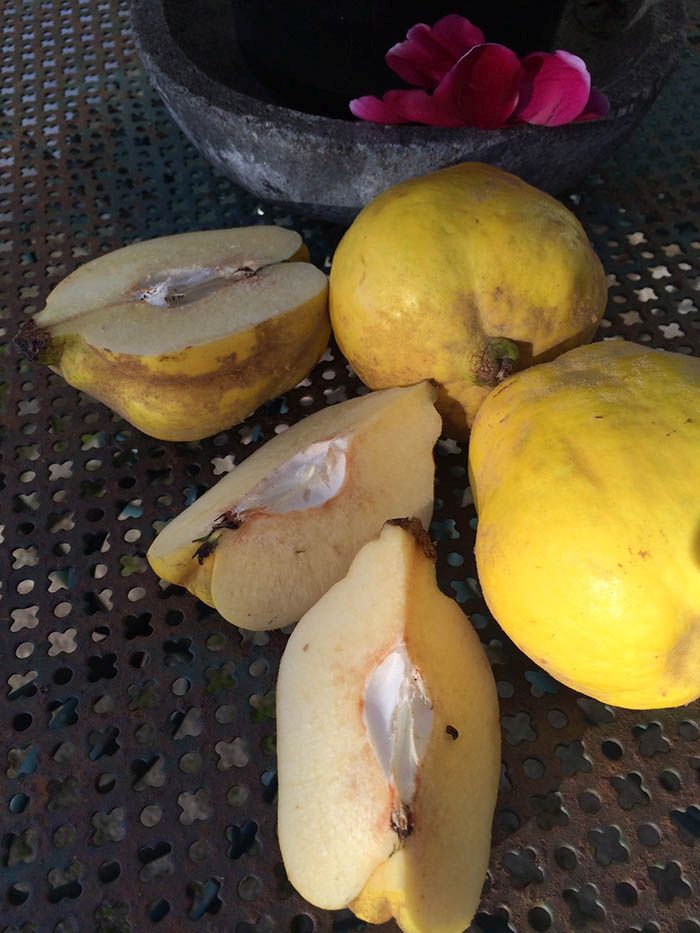
You can also cut quinces into large pieces and slowly simmer them in water for several hours, sometimes overnight, until they becomes soft and change colour. The slower and longer they cook the stronger the colour. Some cooks strain the fruit through muslin and use the pulp to make quince paste or membrillo. Its tart sweet flavour is especially complementary with cheese.
In Morocco, quinces are often combined with meat in savoury tagines. These simple one-pot dishes are easy to make and full of flavour.
To make a Lamb and Quince Tagine, combine 1.5kg cubed lamb in a medium saucepan with 30g butter, 1 1/2 teaspoons ground ginger, 1 teaspoon ground black pepper, 1/2 teaspoon ground coriander, 1/4 teaspoon salt, 1/8 teaspoon cayenne, 1 grated onion and 1 cup water. Bring to the boil, lower heat and simmer, covered, for about an hour. Add four medium onions, peeled and cut into chunks and simmer until the meat is very tender and the sauce thickening – take the lid off during the last 15 – 20 minutes to reduce the liquid.
Meanwhile prepare the quinces: rub the fluff off 500g quinces, wash well and cut them into eighths, leaving on the skin and removing the seeds.
Poach the quince slices in a sugar syrup made with 2 cups water and 1/2 cup sugar until tender.
Preheat the oven to 190degC.
Spoon the lamb into an ovenproof dish. Arrange the poached quinces on top in a pretty design and dust with cinnamon sugar. Bake 10 – 15 minutes on upper shelf of oven. Serve straight from the dish accompanied by steamed couscous and a selection of Moroccan salads.
In Cape Malay cuisine in South Africa, grated quinces are combined with salt to make sambals to accompany curries and grilled fish. To make the sambal: peel and grate one medium quince and combine it in a ceramic bowl with 1 teaspoon salt. Allow it to draw for 15 – 20 minutes. Squeeze out all the moisture over the sink. Combine the grated quince with 1 teaspoon crushed garlic, 1 teaspoon finely chopped green or red chill, 30 ml fresh lemon juice and 1/2 bunch chopped coriander leaves.
The tree itself is quite lovely, with large pinkish or white flowers, oval leaves covered with down, and golden, pear-shaped fruit with a wonderful perfume.
English food writer Jane Grigson sings its praises in her Fruit Book:
“In spring on a warm day, if you sit in the lee of flowering quinces, you become quietly aware of a narcissus scent on the puffs of breeze. Very much the scent of the beginnings of love. The furling twist of the bud, pink and white, opens into a globe of pale pink, ruffed with leaves – its mildness goes unnoticed if you walk by without stopping.”
When the fruit begins to drop from the tree, it is ready to be picked and care must be taken not to bruise the flesh. Many commercial growers use cotton gloves to pick their quinces because they bruise easily.
Quinces have often been mistaken for apples or pears and for a long time were in fact classified as Cydonian pears (P. cydonia).
The quince, however, differs from these other two members of the Rosaceae family in that it has many ovules in each section (carpel) whereas the pear (and apple) have only two.
A number of varieties are available including, in order of fruit maturation, ‘De Vrajna’, ‘Smyrna’, ‘Champion’ and ‘Pineapple’. A single tree will crop satisfactorily but does better if cross-pollinated. They are fairly adaptable, growing well in a range of climates, from the subtropics through tocool highlands. Fleck diseases (small reddish-brown spots) can be a problem in coastal areas with high rainfall.
Quinces are deciduous and so are best planted in winter when dormant. Use plenty of organic mulch to help with moisture retention and water frequently during the growing season. Like pears and apples, they are usually trained to grow into an open-centred, vase-shaped tree. Cropping begins after about five years.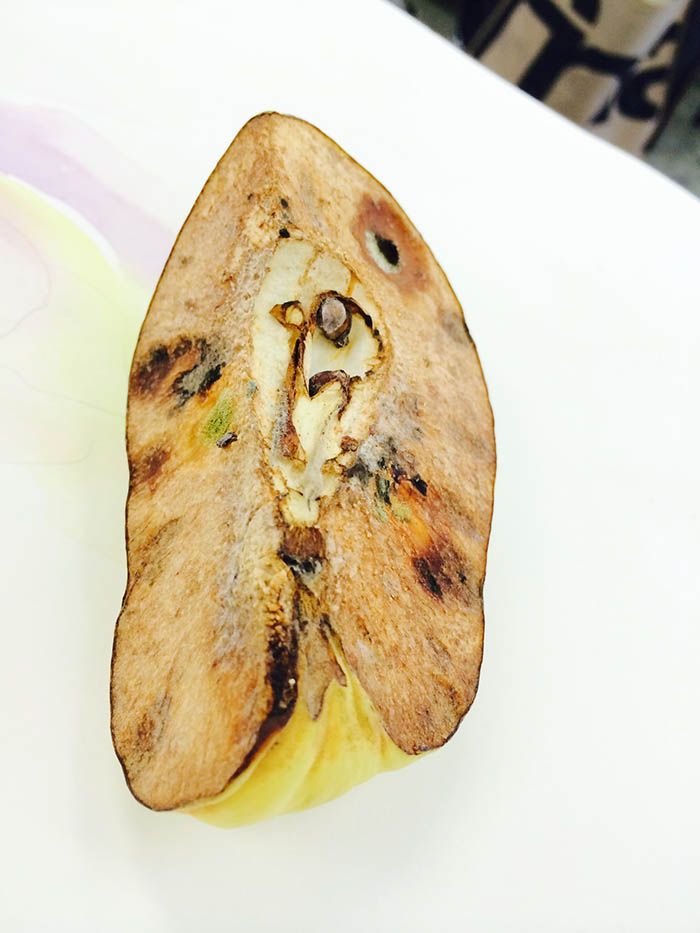
Recently I’ve had something of a different experience with quinces. At my very first Moku watercolour painting class, the teacher, Bronwen Wade, told us that our first project would be to paint quinces and apples.
We sat on stools in a semi-circle around her paint-spattered table as she began to explain her method.
“I want you to go into the fruit,” she said, “Imagine you’re inside it and coming out, going from the unknown into the known.
“Look at the inside and outside of it. Notice where the light is coming from.”
She then cut the fruit into quarters, core, seeds and stem still attached and handed them out to us.
I was given a given a piece of quince. Its skin was slightly green in colour and it had little fragrance as it was the beginning of the season. It didn’t take long before it started to oxidise and change colour and by the end of the class, the cut flesh had become a dark beige.
I took a deep breath. Here I was, once again, facing a blank page. But I had made a commitment and was determined, no matter what the result, to at least try to draw what I saw.
I took a lead pencil and began to draw it side-on with the cut flat part facing me. It looked like a clog and didn’t take me long to realise that this was a very boring way to look at it.
Then I heard Bronwen say,
“Now turn it upside down. Turn it sideways. See what happens.”
I did so, but my drawing was still flat and uninspired (as was I, at this point).
I decided to take a break, have a cup of tea and wander around the room and look at what the others were doing. And that’s when I realised I had to turn my piece of quince around and look at it another way.
And as I looked down along the length of it, I saw something quite different, and began to faintly pencil the shape.
What I saw astonished me: the outer shape of a full, rounded woman and, at her core, the very opening from whence we all come.
We didn’t get back to painting our quinces again for about a month.
I had forgotten about mine and left it in the bottom of my bag in a paper bag, during which time it had shrivelled and become dark brown with splashes of mouldy green and black and white over its surface.
“Oh!’ exclaimed Bronwen when she saw it. “It looks just like an oyster.”
She laughed and asked the others to come and take a look.
“Remember,” she said, “Moku is about happy accidents, pushing back the darks and bringing the lights forward. It’s not for the faint-hearted.”
I’m sure Australian painter Jeffrey Smart knew a thing or two about happy accidents – or perhaps he was being ironic juxtaposing these glossy three-dimensional quinces on the sand against a deep blue sea and sky?


